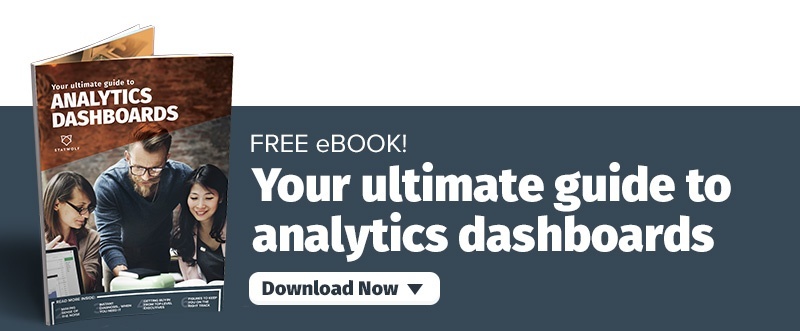Adapt or disappear: Why a marketing dashboard will make all the difference to your ROI
If you were drowning, would you refuse a life jacket? Nope, we thought not, but for modern businesses, our ultra-competitive landscape means that good marketing is the difference between sinking or swimming.
Let’s take the technology sector for example. In recent years, this industry has shifted away from focusing on messaging around their brand and company identity to emphasising customer experience. As we now have so much choice, marketers need to emphasise the consumer as a key value proposition.
Consumers want personalisation and to feel a connection to the product – otherwise, they’ll go elsewhere.
Now, organisations can’t risk leaving lead acquisition to creativity. Instead, analytics has risen up as a new frontier and it’s giving a sizeable advantage to companies who are effectively wielding their data.
Analytics and marketing at large
Ultimately, marketing is a game of decisions. You can ask a customer to contact you for a free demo or consultation in many different ways, but which one actually does the job the best?
Companies rely on data to figure that out. Marketing dashboards are essential to collecting and visualising structured and unstructured data. It’s the type of information that tells you the time of the week that results in the highest click-through rates on email campaigns, or which phrases make the most effective calls-to-action.
A Deloitte study found that leveraging analytics to support marketing efforts ranks as the second most common corporate initiative in the data science field. Financial operations were the most popular use of Big Data, according to the study. More importantly, though: 55 percent of participants saw a clear and discernible improvement from adopting analytics.
However, there’s a caveat: simply collecting the information isn’t enough. Being able to interpret it is where its true value lies. In some cases, marketing managers who utilise dashboards with data visualisation tools have a 28 percent greater likelihood of discovering insights which will generate a significant impact on a campaign’s effectiveness/ROI.
How a marketing dashboard impacts ROI
The difference between high-performing marketing teams and those that are run-of-the-mill is in understanding the numbers.
Vanity metrics are a major roadblock for departments which are just beginning on the road to effectively leveraging Big Data. These metrics are useful for showing if a campaign had an impact, but they offer little insight into how to reconstruct those results.
Generally, vanity metrics include follower counts, landing page visits, and email open rates. They’re useful but they don’t outright impact on the bottom line.
It’s at this point that the road diverges, and marketing teams that recognise they need to dig deeper develop methods of improving and building on the strategies that led to the greatest results.
Rather than following superficial metrics, look for data that can help you evaluate which actions corresponded with the greatest brand impact.
For example:
- Social media engagement through comments and shares.
- Organic and paid search traffic with corresponding bounce rates.
- Click-through rates for email campaigns, and user drop-off points.
- Channels that users are entering from, as well as their path to conversion.
Being able to visualise a customer’s path through a website from a campaign provides full visibility into exactly where a strategy was effective and where it lacked. Was copy misleading, or was there an issue with page functionality?
Without full-funnel analytics, a marketing team will struggle to pinpoint and fix any problems.
The obstacles and rewards that await digital transformation
It’s never easy to get someone to buy into a new idea. Many organisations are already utilising analytics in some capacity, even if it’s not all that effective. But this disconnected approach to Big Data is in fact a leading barrier to its adoption.
Approximately 55 percent of companies view decentralised analytics technology as a major inhibitor to its overall success, Deloitte has reported. So it’s no surprise that this is an underlying factor behind the recent surge in popularity of marketing dashboards, which mine data from a variety of sources and seamlessly put it all together in one place, allowing you to easily and quickly visualise it for simple consumption. This, as one database marketing executive puts it, offers unparalleled insight into marketing initiatives.
“We’re not really spending money on data analytics,” the survey participant told Deloitte. “We’re using it to find better alternatives for making money.”
Marketing dashboards give companies the potential to spot trends and tactics that support higher conversion rates across a variety of channels. They’re also able to track correlations between consumer activity and changes in overall business operations and adjust appropriately.
Ultimately, a marketing dashboard is the lifejacket that can help your business stay afloat – so why wouldn’t you take it?
See your data in a different light
Don’t invest in analytics without thinking about the technology behind it. Marketing dashboards make it easy to collate data from a variety of sources to easily derive actionable insights.
Interested in learning more? Contact our team of experts, or schedule a demo today.



